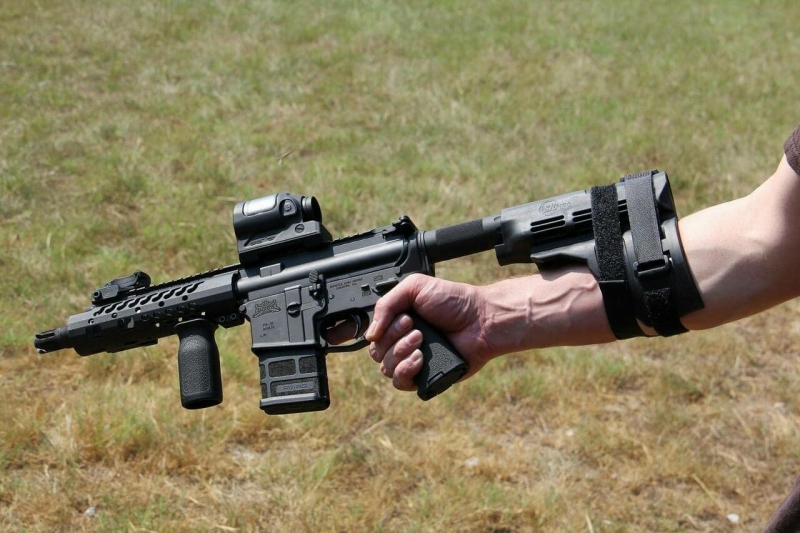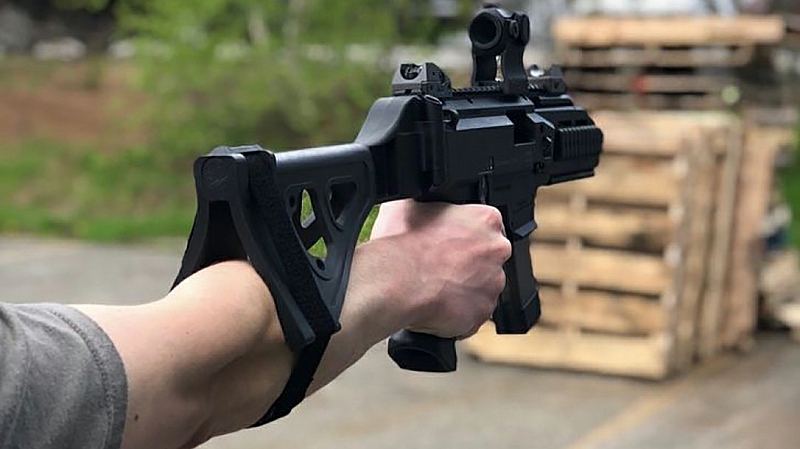A Federal District Judge has denied a request for preliminary injunction against the Bureau of Alcohol, Tobacco, Firearms, and Explosives’ (ATF) Final Rule on stabilizing pistol braces. Federal District Judge Reed O’Connor ruled that plaintiffs Maxim Defense and the Firearms Policy Coalition (FPC) “have not shown they are entitled to the extraordinary remedy of preliminary injunctive relief.”

Maxim Defense and FPC challenged the Final Rule on six grounds:
- That it violates the Second Amendment.
- That it violates the First Amendment by chilling speech in terms of advertising.
- That it violates due process as protected by the Fifth Amendment.
- That it violates the Constitution’s structural provisions.
- That it violates the Administrative Procedures Act (APA) because it exceeds ATF’s authority.
- “That it violates the APA’s procedural requirements because it was not a logical outgrowth of the proposed rule.”
Judge O’Connor ruled against all six charges in denying the preliminary injunction. Some may be surprised at O’Connor’s ruling considering he previously ruled against the ATF in the Frames and Receivers case and the Bump Stock case.
But disappointing as it may be, O’Connor cogently explains his reasoning for each of the six charges. And careful reading of the decision leaves grounds for hope that the case itself, which is ongoing, may yet favor the plaintiffs. Let’s look briefly at each charge, along with Judge O’Connor’s comments, hopefully without getting bogged down in legal jargon. O’Connor addressed the charges out of order, so we will follow his lead.
The Administrative Procedures Act
Judge O’Connor notes that the National Firearms Act of 1934 (NFA) regulates certain firearm categories, including, in this case, short-barreled rifles. Congress charged the US Attorney General with enforcing the NFA. After the 1968 Gun Control Act (GCA), the Attorney General delegated the enforcement of both statutes to the ATF.
As the enforcing authority, ATF is required to create and implement rules facilitating that enforcement. The plaintiffs allege that the Final Rule exceeds ATF’s authority because the agency “has not been delegated authority to interpret the statutorily defined and unambiguous term ‘rifle’ and, second, even if it could, the Final Rule’s interpretation is inconsistent with the statutory term’s plain meaning.”

O’Connor wrote that “the statutory definition of ‘rifle’ uses terms such as ‘designed,’ ‘redesigned,’ ‘remade,’ and ‘intended,’ words that necessarily require the enforcing agency-or anyone who would comprehend the statute’s meaning-to evaluate objective weapon characteristics, and perhaps conduct, to decide whether a particular firearm is subject to the NFA.”
“Rules explaining when a brace or stabilizer actually redefines a firearm or remakes a firearm sufficiently to a short-barreled rifle are therefore permissible,” he added. “It does not, as Plaintiffs suggest, rewrite the definition itself. In short, it does not appear that the Final Rule so clearly contradicts the statutory definition of ‘rifle’ that preliminary injunctive relief is in order.”
Judge O’Connor goes on to say that the second charge regarding the APA is not valid because it is based on the fact that the Final Rule does not follow the proposed rule in terms of including a worksheet for a points system. This change was made based on the public comments on the proposed rule, meaning the public had been sufficiently notified.
Structural Constitutional Protections
The plaintiffs charged that the Final Rule is unconstitutional because it essentially creates federal law that potentially carries criminal penalties. In such a case, the implementing agency would require “a clear delegation” from Congress, which ATF does not have. O’Connor wrote that “the Final Rule interprets-but does not rewrite-the underlying statutes.” He denied the plaintiff’s arguments based on that finding.
The First Amendment Claim
The plaintiffs claim that ATF is making regulations based on what manufacturers say about their products and how they advertise their use. Such practices, therefore, chill free speech as manufacturers fear that ATF will use their statements and advertising to classify or reclassify a firearm for the purpose of the NFA, since the Final Rule allows the agency discretion to apply such criteria.
O’Connor denied this claim, writing that “While the First Amendment provides robust speech protections and ‘generally prohibits the government from proscribing speech [based on its] disapproval of the ideas expressed,’ no speech is being proscribed here. Rather, the Final Rule notifies the public that the government will listen to what they say about the products they manufacture and purchase…Thus, on this claim, Plaintiffs have not shown that they are substantially likely to succeed on the merits.”

The Fifth Amendment Claim
The plaintiffs argue that the Final Rule is vague, thus violating the Fifth Amendment’s due process guarantee. The Final Rule is unconstitutionally vague, they charge, because ATF is permitted to apply a set of imprecise criteria to decide whether a weapon is subject to NFA regulation. They further allege that the “discretion-laden process does not provide any useful guidance to regulated parties.”
Judge O’Connor countered that argument by saying that, while the standards may be imprecise, they are standards nonetheless, and therefore not sustainable as being overly vague. “Hence,” he wrote, “while the Final Rule’s factoring criteria may be imprecise, it is comprehensible enough to put a person of ordinary intelligence on notice that their weapon may be subject to federal firearms laws. Thus, at this stage, Plaintiffs have not shown a substantial likelihood of success on the merits of their Fifth Amendment claim.”
Second Amendment Claims
The plaintiffs claim the Final Rule “impermissibly infringes on the ‘right of the people to keep and bear Arms’…because ‘when firearms are in common use at the [present] time,’ they cannot be banned.” The plaintiffs claim this protection “extends not just to braced pistols, but to the braces themselves.” Judge O’Connor shot that down by observing that the Final Rule does not ban pistol braces, nor firearms equipped with them. It regulates those items, which isn’t the same as a ban. He shows that this is consistent with the Bruen Decision by citing Justice Brett Kavanaugh’s concurring opinion.
He also notes that the Final Rule does not regulate stabilizing braces themselves. They are only subject to regulation once they are attached to a firearm. Therefore, Maxim Defense may still sell pistol braces and customers may purchase them without regulation unless they are attached to a firearm.

Finally, the plaintiffs claim that, under Bruen, the Final Rule violates the Second Amendment because there is no historical tradition of regulating such common use items, which are entitled to heightened protection under both Heller and Bruen.
Judge O’Connor noted the validity of that claim, but also wrote that the plaintiffs had submitted only “minimal historical analysis” bearing on the claim. “Though the historical record may support such a result at the summary judgement stage, the briefing presently before the Court is not sufficient to justify the extraordinary remedy of preliminary injunctive relief. As such, the Court finds that Plaintiffs are not likely to succeed on the merits of their Second Amendment claims at this juncture.”
In Sum
“Plaintiffs have not shown they are entitled to the extraordinary remedy of preliminary injunctive relief. While Plaintiffs may ultimately prevail on summary judgment, the Court finds that they have not, at this preliminary stage, demonstrated a substantial likelihood of success on the merits of at least one of their claims. Failure to satisfy this element necessarily bars their request for injunctive relief.”
What it Means
Honestly, while somewhat disappointing, the denial of a preliminary injunction isn’t really damaging to the case. All it means is that the plaintiffs failed to show its necessity, which is why I included the judge’s words addressing their chances of succeeding on the claims’ merits. That is an absolute requirement for a preliminary injunction. The case will move forward, and each side will have their say before the court.

In a way, this is a good thing, because it shows the plaintiffs where they got it wrong and where they should improve their arguments. It also shows that Judge O’Connor is playing this case by the book. If we honestly believe the law is on our side here, then we should welcome that. We want judges who follow the law.
The actual court proceedings will allow the plaintiffs to expand their arguments and introduce supporting evidence that they perhaps did not have time to develop because this hearing came so quickly after the Final Rule was issued. Invoked properly, Heller and Bruen may yet save the day. Judge O’Connor himself noted that the plaintiffs may well prevail in court.
So, while we might wish we had the injunction in hand, its denial is really a minor setback that may yet prove beneficial. The pro-gun side lost a skirmish, but the campaign is still before us, and now we know more about the campaign environment. Stay tuned.


